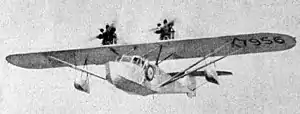Towle WC
The Towle WC, aka Towle TA-1, was a custom built aircraft for a 1929 round-the world flight.
| WC | |
|---|---|
 | |
| Role | Amphibious aircraft |
| National origin | United States of America |
| Manufacturer | Towle Marine Aircraft Engineering Company |
| Designer | Thomas Towle |
| First flight | November 1928 |
| Introduction | 1928 |
| Number built | 2 |
| Variants | Towle TA-2 |
Design and development
Thomas Towle was an engineer who had been involved with many early aircraft designs. Having just co-designed the Eastman-E2 Sea Rover, Towle was commissioned by Henry McCarroll to promote Detroit's aviation production capabilities.[1]
The WC was a flying boat with an aluminum hull. The strut braced parasol wing was fabric covered.[2][3]
Operational history
The prototype WC flew as far as Brazil before engine reliability issues forced the cancellation of the round-the-world flight attempt.[4]
Variants
- Towle TA-2 Was built as a successor to the WC model
Specifications (Towle WC)
Data from Flight
General characteristics
- Capacity: 4
- Length: 35 ft (11 m)
- Wingspan: 52 ft (16 m)
- Empty weight: 2,750 lb (1,247 kg)
- Gross weight: 4,420 lb (2,005 kg)
- Powerplant: 2 × Comet R-612 Seven cylinder radial, 150 hp (110 kW) each
Performance
- Maximum speed: 100 kn (115 mph, 185 km/h)
- Minimum control speed: 39 kn (45 mph, 72 km/h)
Aircraft of comparable role, configuration, and era
References
Wikimedia Commons has media related to Towle WC.
- Robert F. Pauley. Michigan Aircraft Manufacturers.
- E. R. Johnson. American flying boats and amphibious aircraft: an illustrated history. p. 324.
- Flight: 149. 21 Feb 1929.
{{cite journal}}: Missing or empty|title=(help) - Robert F. Pauley. Michigan Aircraft Manufacturers.
This article is issued from Wikipedia. The text is licensed under Creative Commons - Attribution - Sharealike. Additional terms may apply for the media files.